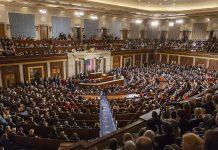
When $172 million in luxury jets land in the lap of a government official during a shutdown, it’s not just a headline—it’s a seismic moment that puts the priorities and transparency of Washington’s power players under a microscope.
Story Snapshot
- Kristi Noem’s request for luxury Gulfstream V jets triggers scrutiny over $172 million in spending.
- Democratic lawmakers challenge the timing and source of funding during a government shutdown.
- The Coast Guard defends the purchase, citing outdated and unreliable current fleet.
- Political fallout and public debate intensify over necessity versus extravagance in government procurement.
Luxury Jets in a Time of Austerity: The $172 Million Question
Kristi Noem, Secretary of Homeland Security, asked for new Gulfstream V jets, and the Coast Guard delivered, budgeting $172 million for the acquisition. The timing—amid a government shutdown—ignited controversy. Critics latched on, especially Democratic lawmakers, who questioned why, in a period of fiscal constraint, leadership comfort was prioritized over frontline Coast Guard needs. The echoes of past luxury aircraft scandals reverberated through Congress and social media, with many wondering if history was repeating itself.
The Coast Guard justified the decision, pointing to the age and unreliability of its existing jets, which are over 20 years old. Acting Commandant Kevin Lunday described the fleet as “well beyond operational usage hours for a corporate aircraft,” highlighting how antiquated avionics and fragile communications jeopardized the secure, on-demand mobility expected of agency leaders. Their argument: national security operations demand reliable transportation that can connect instantly with the White House and other agencies. Yet, the optics of luxury during a period of government belt tightening have left lawmakers and the public unconvinced.
Congressional Showdown: Accountability and Justification
Democratic Representatives Lauren Underwood and Rosa DeLauro spearheaded a formal challenge, demanding clarity on the funding source and criticizing Noem’s leadership choices. Underwood underscored Noem’s existing access to Gulfstream V aircraft, questioning the necessity of additional acquisitions. Coast Guard leadership maintained the jets were essential for secure communications and operational readiness, but the lack of transparency about where the money came from—especially during a shutdown—only fueled skepticism.
HOW ABOUT TAKE CARE OF “AMERICA FIRST???” Kristi Noem gets luxury $172M jets she had asked for prompting questions over where the funding is coming from" – The Independent #SmartNews https://t.co/2ekQL5SHQH
— Linda Dodge (@ldodge448) October 19, 2025
Noem responded by stressing that some newly appropriated funds were being used to ensure Coast Guard members didn’t miss paychecks. This, she argued, showed her commitment to those on the front lines. However, critics countered that the timing and scale of the jet purchase suggested misplaced priorities, focusing on luxury rather than operational needs.
Political, Economic, and Social Fallout: Who Pays for Luxury?
The $172 million jet purchase has become a lightning rod for broader debates over government spending and accountability. Taxpayers, already wary during a shutdown, see another example of extravagance in Washington. Coast Guard personnel face uncertainty about budget priorities and pay, while Noem and DHS battle questions about stewardship of public funds.
Political repercussions loom large. Congressional appropriations committees may respond with stricter oversight and transparency requirements for executive aircraft purchases. The reputational stakes are high—not just for Noem, but for the Coast Guard and DHS. The aerospace industry stands to benefit from government contracts, but the controversy may spark calls for more competitive bidding and justification for future purchases. The incident’s legacy could set a precedent, shaping future debates about luxury versus necessity in government procurement.
Expert and Industry Perspectives: Necessity or Excess?
Defense analysts acknowledge the operational need for secure, reliable aircraft, especially for leaders in national security. Procurement experts emphasize transparency and competitive bidding, while public administration scholars critique the absence of clear funding sources and the problematic timing of the purchase. Political scientists view the episode as emblematic of the persistent tension between executive autonomy and legislative oversight.
Supporters of Noem argue that modern jets are essential for effective leadership in national security, but critics see the purchase as excessive and poorly timed. The controversy has amplified partisan divisions and intensified calls for greater accountability in government spending. The central question remains: when national security is at stake, how much luxury is justified, and who decides where the line is drawn?
Sources:
Kristi Noem Gets $172M Luxury Jets as Democrats Raise Concern Over Funding Source



